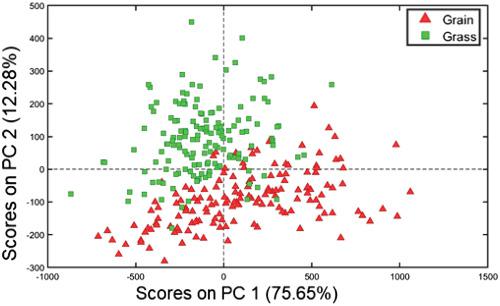当前位置:
X-MOL 学术
›
J. Raman Spectrosc.
›
论文详情
Our official English website, www.x-mol.net, welcomes your
feedback! (Note: you will need to create a separate account there.)
Analysis of Raman spectra for the verification of Australian grass‐ and grain‐fed beef using principal component analysis and partial least square models
Journal of Raman Spectroscopy ( IF 2.4 ) Pub Date : 2020-09-02 , DOI: 10.1002/jrs.5983 Bridgette G. Logan 1, 2, 3 , David L. Hopkins 1, 2 , Leigh M. Schmidtke 4 , Stephanie M. Fowler 1, 2
Journal of Raman Spectroscopy ( IF 2.4 ) Pub Date : 2020-09-02 , DOI: 10.1002/jrs.5983 Bridgette G. Logan 1, 2, 3 , David L. Hopkins 1, 2 , Leigh M. Schmidtke 4 , Stephanie M. Fowler 1, 2
Affiliation

|
The diet of cattle has been shown to alter both subcutaneous fat and muscle fatty acid composition, and these differences cause a change in the Raman spectra of the fat due to the different chemical bonds associated with these biochemical changes. Because biochemical changes only lead to subtle changes in the Raman spectra, statistical methods based upon chemometric modelling are necessary to extract indicative information on the type of feed consumed. This investigation undertook a feasibility study using a limited sample set derived from two producers in one location to ascertain the potential for Raman spectroscopy to accurately discriminate grain‐fed cattle from grass‐fed cattle and investigated the usefulness of principal component analysis (PCA) and partial least squares discriminate analysis (PLS‐DA) to best discriminate between feeding groups using the information from the Raman spectra. The first two principal components accounted for 83% of the variation in the spectra and demonstrated discrimination of samples by feed type. PLS‐DA resulted in a model that was able to accurately predict grain‐ and grass‐fed carcases with a misclassification rate of 3.5%. Changes in beef cattle diets lead to subtle changes in subcutaneous fat; using Raman spectroscopy with chemometric modelling, these changes can be identified and used to identify the production system of beef products. This study successfully uses Raman spectroscopy as an automated, nondestructive and rapid technique in the range of 600–2000 cm−1 in combination with pattern recognition of unsupervised (PCA) and supervised (PLS‐DA) techniques to classify the production system of cattle between grain and grass fed.
中文翻译:

使用主成分分析和偏最小二乘模型对拉曼光谱进行分析以验证澳大利亚草饲和谷物饲喂的牛肉
牛的饮食已显示会改变皮下脂肪和肌肉脂肪酸组成,并且由于与这些生物化学变化相关的不同化学键,这些差异导致脂肪的拉曼光谱发生变化。由于生化变化只会导致拉曼光谱发生细微变化,因此需要基于化学计量学模型的统计方法来提取有关所消耗饲料类型的指示性信息。这项研究进行了可行性研究,使用了来自一个地点的两个生产商的有限样本集,以确定拉曼光谱法准确区分草食牛和草食牛的潜力,并调查了主成分分析(PCA)和部分成分分析的有用性最小二乘方差分析(PLS-DA)使用拉曼光谱中的信息来最佳地区分进食组。前两个主要成分占光谱变化的83%,并证明了按进料类型区分样品。PLS-DA生成的模型能够准确地预测谷物和草食的car体,误分类率为3.5%。肉牛饮食的变化导致皮下脂肪的细微变化;使用拉曼光谱和化学计量学建模,这些变化可以被识别并用于识别牛肉产品的生产系统。这项研究成功地将拉曼光谱法用作一种自动,无损和快速的技术,范围在600–2000 cm-1与无监督(PCA)和有监督(PLS-DA)技术的模式识别相结合,可以对谷物和草饲之间的牛的生产系统进行分类。
更新日期:2020-09-02
中文翻译:

使用主成分分析和偏最小二乘模型对拉曼光谱进行分析以验证澳大利亚草饲和谷物饲喂的牛肉
牛的饮食已显示会改变皮下脂肪和肌肉脂肪酸组成,并且由于与这些生物化学变化相关的不同化学键,这些差异导致脂肪的拉曼光谱发生变化。由于生化变化只会导致拉曼光谱发生细微变化,因此需要基于化学计量学模型的统计方法来提取有关所消耗饲料类型的指示性信息。这项研究进行了可行性研究,使用了来自一个地点的两个生产商的有限样本集,以确定拉曼光谱法准确区分草食牛和草食牛的潜力,并调查了主成分分析(PCA)和部分成分分析的有用性最小二乘方差分析(PLS-DA)使用拉曼光谱中的信息来最佳地区分进食组。前两个主要成分占光谱变化的83%,并证明了按进料类型区分样品。PLS-DA生成的模型能够准确地预测谷物和草食的car体,误分类率为3.5%。肉牛饮食的变化导致皮下脂肪的细微变化;使用拉曼光谱和化学计量学建模,这些变化可以被识别并用于识别牛肉产品的生产系统。这项研究成功地将拉曼光谱法用作一种自动,无损和快速的技术,范围在600–2000 cm-1与无监督(PCA)和有监督(PLS-DA)技术的模式识别相结合,可以对谷物和草饲之间的牛的生产系统进行分类。











































 京公网安备 11010802027423号
京公网安备 11010802027423号